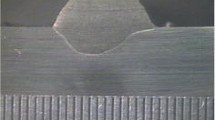Abstract
The determination of the welding parameters for pipeline welding is based on a skilled welder's know-how and long-term experiences rather than on theoretical and analytical techniques. In this paper, an intelligent system for the determination of welding parameters for each pass and welding position, for pipeline welding based on one database and a finite element method (FEM) model, and on two back-propagation (BP) neural network models and a corrective neural network (CNN) model was developed and validated. The preliminary test of the system has indicated that the system could determine the welding parameters for pipeline welding quickly, from which good weldments can be produced without experienced welding personnel. Experiments using the predicted welding parameters from the developed system proved the feasibility of interface standards and intelligent control technology to increase productivity, improve quality and reduce the cost of system integration.










Similar content being viewed by others
References
Lucas W, Brightmore AD (1988) The welding institute approach to writing information software for welding engineers. In: Welding Quality, The role of computers, Pergamon, Vienna, pp 141–157
Lebacq C, Brechet Y, Shercliff HR, Jeggy T and Salvo L (2002) Selection of joining methods in mechanical design. Materials and Design 23:405–416
Galopin M and Boridy E (1986) Statistical experiment in arc welding. In: Proceedings of an International Conference on Trends in Welding Research, May 1986, pp 719–722
McGlone JC (1980) The submerged arc butt welding of mild steel—A decade of procedure optimization. The Welding Institute Report 13/1980/PE
Shinoda T and Doherty J(1978) The relationship between arc welding parameters and weld bead geometry: a literature survey. The Welding Institute Report 74/1978/PE
Sabapathy PN, Wahab MA and Painter MJ (2001) Numerical models of in-service welding of gas pipelines. J Mat Proc Technol 118:14–21
Murguan S, Kumar PV, Raj B and Bose MSC (1998) Temperature distribution during multipass welding of plates. Int J Pressure Vessels Piping 75:891–905
Tang YS, Yeh SS and Juang SC(1997) Fuzzy pattern recognition of tungsten inert gas weld quality Int J Advan Manufac Technol 13:387–392
Chandel RS (1988) Mathematical modeling of gas metal arc weld features. Proceedings of the Fourth International Conference on Modeling of Casting and Welding Processes, April 1988, pp 109–120
Yang LJ, Chandel RS and Bibby MJ (1992) The effects of process variables on the bead height of submerged-arc weld deposits. Can Metall Q 31(4):289–297
Juang SC, Tarng YS and Lii HR (1998) A comparison between the back-propagation and counter-propagation networks in the modeling of the TIG welding process. J Mat Proc Technol 75:54–62
Nagesh DS and Datta GL (2002) Prediction of weld bead geometry and prediction in shielded metal-arc welding using artificial neural networks. J Mat Proc Technol 79:1–10
Tarng YS and Yang WH (1998) Optimization of the weld bead geometry in gas tungsten arc welding by the taguchi method Int J Advan Manufac Technol 14:549–554
Crouch J (1992) Expert system to optimize the selection of shielding gas Welding Review 11, No. 3:123–124
Lovegrove GL, Curtis GJ and Farrar RA (1990) A PC-based expert system in engineering. In: Proc. 3rd International Conference on Industrial Engineering Applications for Artificial Intelligence Expert Systems, ACM, New York, pp 653–659
Madden S, Vandervelt H and Jones J (1992) Intelligent automated welding for shipyard applications. J Ship Prod 2:77–78
Park JY and Hwang H (2001) Determination of optimal welding parameters for an automatic welding in the shipbuilding Int J Korea Welding Soc 1(1):17–22
Eisler GR and Fuerschbach PW (1997) SOAR: An extensible suite of codes for weld analysis and optimal weld schedule. Seventh International Conference on Computer Technology in Welding, NIST, San Francisco, California, pp 257–268
SYSWELD(1999) Simulation of the effects of welding (User's Manual), Framasoft+CSI
Burke L and Ignizio JP (1997) A practical overview of neural network J Int Manufac 8:157–165
Bishop C (1995) Neural networks for pattern recognition Oxford University Press, Oxford, UK
Portmann N(1996) Application of neural networks in rolling mill automation. Iron Steel Eng 72(2):33–26
Acknowledgement
The work has been undertaken and done at QUT and funded by ARC during the stay in Australia.
Author information
Authors and Affiliations
Corresponding author
Rights and permissions
About this article
Cite this article
Kim, I.S., Jeong, Y.J., Lee, C.W. et al. Prediction of welding parameters for pipeline welding using an intelligent system. Int J Adv Manuf Technol 22, 713–719 (2003). https://doi.org/10.1007/s00170-003-1589-y
Received:
Accepted:
Published:
Issue Date:
DOI: https://doi.org/10.1007/s00170-003-1589-y




